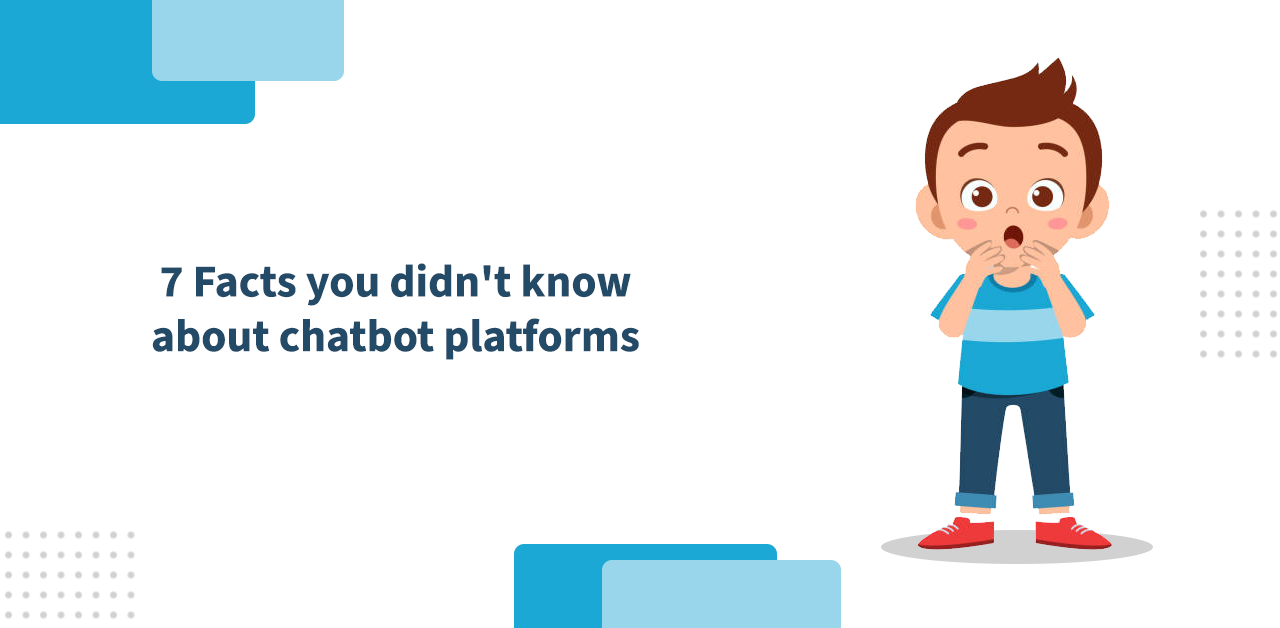A chatbot is a conversational agent that uses artificial intelligence. It can handle quick queries for your business, including orders, marketing, and customer service. However, this is just the tip of the iceberg. They can do so much more. Chatbots with automation help your brand's CX strategy for creating dynamic customer experiences. It helps transform messaging channels into conversational marketing. By mid-2016, many companies had launched over 11,000 Facebook Messenger bots. Yes, there was a time when chatbots had poor CX, unable to follow simple commands, or didn't live up to the mark of customer requests and human agents. But with advanced artificial intelligence, chatbots are booming in the market. The latest chatbots are easy to use and easily interface with robust integrations and valuable features. You may be wondering, why are we saying all these about chatbots? Well, many chatbot facts are unknown. So, in this post, we will go through the things you probably didn't know about chatbots.
Types of Chatbots
Virtual assistants: They aid you in finding information, remembering things, and making purchases. Consider Siri from Apple, Alexa from Amazon, Cortana from Microsoft, and Assistant from Google. Machine learning uses artificial intelligence to power them to learn and figure out what they want. Messaging applications: It effectively allows companies and brands to remain online and provide customer service 24 hours a day, seven days a week (e.g., instant responses, quick answers, complaint resolution). Consider the messaging apps Facebook Messenger, Kik, WeChat, and Slack. Chatbots of this sort can only engage with people by following pre-programmed rules. What you've seen and experienced thus far is only the beginning of a billion-dollar industry that will be worth billions in less than ten years. Several well-known companies have already employed Chatbots, including Uber, Sephora, and CNN.
7 Facts you didn't know about chatbot platforms

The first coined term for chatbot was "chatterbot" in 1994
In 1994, computer scientist Michael Mauldin coined the term "chatterbot," which later developed into the chatbot. Even though chatbots have existed for about 30 years, Michael Mauldin's invention of Verbot in the mid-90s gave them a proper name. Verbot is a combination of the words "verbal" and "robot," It arose from Mauldin's first chatbot prototype, Julia. Since retiring from professional wrestling, Mauldin currently competes in the Robot Fighting League.
You can create a chatbot without coding.
The good news is that you don't have to be professional to use a chatbot. There are several low-code and no-code chatbot options available these days. By employing chatbot platforms, you can drastically enhance your company's agility and reduce time to market and software development expenses. You don't need to recruit expensive full-time engineers.
First chatbot – ALICE
In 1995, ALICE was one of the first chatbots invented. After more than two decades, you'll see that ALICE isn't that different from our chatbots. ALICE's replies are based on natural language processing models. She and her designer, Richard Wallace, have received several accolades for their inventiveness. If you ask ALICE a broad, open-ended question, she will dodge like a pro. To put it another way, she'll respond to the question with a question.
Chatbots aren't only for customers.
You can employ chatbots for various purposes, not all customer-facing. Sales and marketing departments, for example, can use chatbots to help with lead creation. You may discuss with a chatbot to input the information when sales professionals discover a new prospect or have a recent conversation with a client. You can transfer this data to your CRM (customer relationship management) program. Human resources, operations, management, and finance are some of the other internal chatbot use cases.
Consumers buy things via Chatbots.
37% of Americans believe they are willing to make a transaction using a chatbot. Consumers would spend more than $55 on average for each item. According to Myclever Agency, 33% of UK citizens would buy essential products like clothes and food if a chatbot was accessible.
Customers increasingly prefer chatbots.
Chatbots can tackle common customer care concerns 24 hours, seven days a week, unlike human support employees. Instead of letting clients wait in long lines to interact with a human agent, chatbots are accessible to serve them right away. Human agents can spend more time with and give better service to clients who have more complex problems by putting chatbots to focus on readily solved issues.
Consumers Want Recommendations From Chatbots
According to DigitasLBi, 37 percent of all customers — and 48 percent of millennials — are receptive to receiving recommendations or guidance from chatbots. Consumers are most interested in product recommendations from retail shops (22 percent), hotels/accommodations (20 percent), travel (18 percent), pharmaceutical items (12 percent), and fashion/style (9 percent).
Bonus Facts

Chatbots would be very advanced than human intelligence by 2029
By 2029, Ray Kurzweil, a Google inventor, futurist, and engineer (who tends to make correct predictions), expects that chatbots will acquire human-level linguistic abilities. "You'll be able to have a meaningful discussion with an AI in 2029 if you think you can have a meaningful conversation with a human."
The first chatbot came alive in 1966.
In 1966, Joseph Weizenbaum developed ELIZA, a computer program that mimicked the actions of a human therapist. Weizenbaum, an MIT professor, alongside Alan Turing and John McCarthy, pioneered AI research. They aimed to construct a software that "tricked" people into thinking they were chatting with a person. ELIZA worked similarly to a current chatbot, responding to keywords with a pre-programmed answer. People believed they were speaking with a human because of "her" capacity to ask open-ended inquiries using "DOCTOR" scripts.
You can purchase things via a chatbot.
According to a poll conducted in 2017, more than 20% of customers in the United Kingdom would consider making a purchase using a chatbot. Furthermore, this group is willing to spend an average of £315 on a chatbot-assisted transaction. These numbers are likely to have arisen in the years afterward, as customers have become more comfortable with chatbots in their daily lives.
In contrast, animals are considered brighter than chatbots.
According to Colin Allen, a specialist in artificial intelligence ethics at the University of Indiana, Chatbots still have much to learn. Animal behavior can also assist chatbots is becoming more competent. Siri and other digital personal assistants require context to comprehend an inquiry and provide an appropriate response ultimately. According to Allen, humans adjust their queries when chatbots don't understand something. If chatbots become the highly trained assistants we want them to be, something must alter. Animals are better at inferring context and making judgments in the face of ambiguity, relying on their senses such as sight and hearing. Computer scientists can learn more about this phenomenon by studying it.
People Want to Contact Retailers via Chat
According to 24/7, 29 percent of customers prefer to contact shops using online chat and messaging applications while making a purchasing choice. That implies individuals are equally likely to reach a shop via phone or through a chatbot, with the latter being more probable than the former (27 percent).
It's possible to "break" a chatbot.
When you "break" a chatbot, it doesn't mean it'll stop working. It merely identifies it as a machine with artificial intelligence. If you're unsure if you're speaking with a human or a bot, ask a series of open-ended inquiries, such as "How are you feeling?" You'll almost always get a canned response indicating chatting with a machine. Some bots are more challenging to break than others, and ALICE turns out to be one of them, despite her age.
A new gender-neutral automated assistant is Q
If you've ever used one, you can set up an automated personal assistant to utilize conventionally masculine or female voices. The world now has its first gender-neutral personal assistant. Audio researchers gathered speech data from non-binary persons to create Q, the genderless voice. It is especially significant because of the United Nations' conclusions that the voices of Siri and Alexa perpetuate gender stereotypes and prejudices.
Conclusion
Chatbots assist people with the help of Artificial Intelligence. People love to chat with chatbots as they are available 24*7 with excellent customer satisfaction. Many Chatbot Platforms provide no-code chatbots to users. These days chatbots are very flexible and highly customizable to the customers' needs. Facebook has evolved from a photo-sharing and people communicating app to an online store with a huge marketing platform for different items. Buying items from online stores has many benefits for customers and sellers. If you want to provide these benefits to your consumers, meet BotPenguin. Try it today. It's Free!











